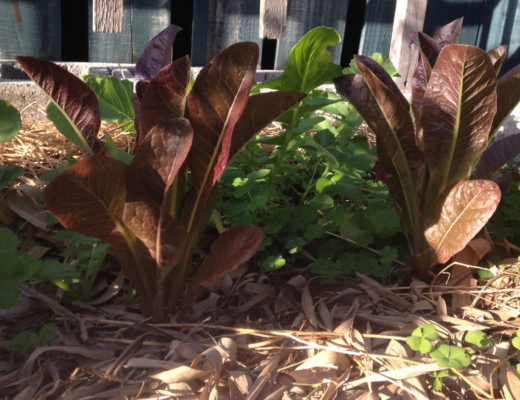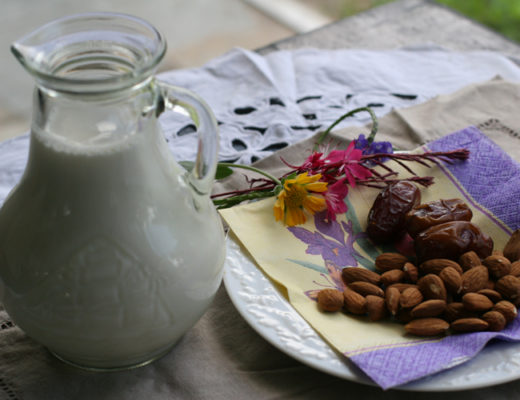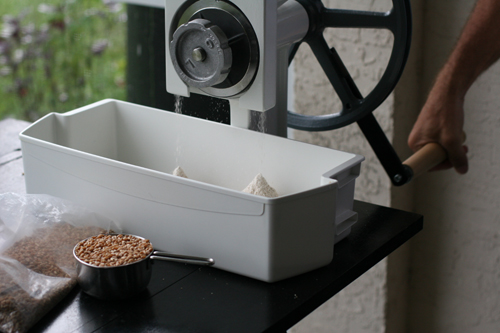Soil is any mix of sand, silt, clay, and organic matter. Soil texture is determined by the proportions of each of these components. When organic matter is added along with water and gases, biological processes take place that affect soil structure. These factors along with other conditions such as sunlight, temperature, and precipitation determine which plants will grow in any given location.
When growing plants in containers, you can create a mixture that has the favorable soil conditions for the type of plant you are trying to grow. Soil for containers needs to be well aerated and well drained while still being able to retain enough moisture.
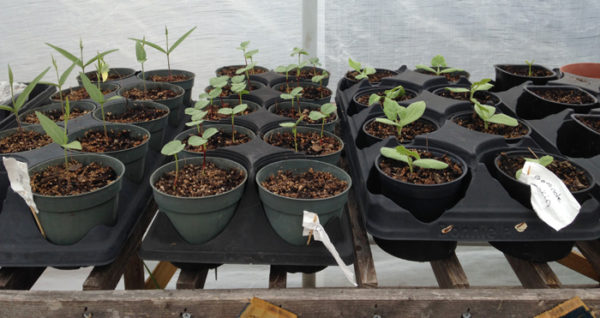
You can use soil from your garden, but it will need to be modified to create a lighter mix with better moisture retention. Garden soil tends to be dense, and can become easily compacted. It also may contain weed seeds and plant diseases. For this reason you may wish to sterilize it first by heating it in the oven to a temperature of 180 to 200 degrees Fahrenheit for about 30 minutes.
Many potting mixes do not contain any soil at all. The three primary ingredients in most commercial organic potting mixes are peat moss, pine bark, and either perlite or vermiculite (to provide air space). To this, manufacturers usually add organic fertilizer and amendments for soil structure. Many of these fertilizers are byproducts of industrialized animal agriculture. They can contain things such as animal manures, blood meal, bone meal or bone ash, feather meal, egg shells, and fish emulsion. These things are not always listed on the label.
Below is a list of just some of the plant and mineral based organic fertilizers that can be included in a veganic potting mixture.
Plant based fertilizers:
- Alfalfa, cottonseed, and soy meals: These are a good source of nitrogen (alfalfa 2.5 %, cottonseed 7%, soybean 6.5%, approximately.) They have a slow to medium rate of release. It is important that they be listed as organic, because some may come from crops that have been genetically modified and sprayed with pesticides. Alfalfa and cottonseed meals will also add potassium (alfalfa about 2%, cottonseed about 1.5 %.) Alfalfa will add a few trace minerals. Soybean meal is also a source of phosphorous (about 2%.)
- Composted plant material: Compost helps with soil structure by adding organic matter. Good compost contains many beneficial organisms which help free up the availability of nutrients to your plants.
- Kelp meal: Kelp meal will add some potassium, but it is mostly prized for its valuable micronutrients that can increase yields and reduce plant stress.
- Humic acid: Consists of organic compounds found in compost. Humic acids increase soil microbial activity, improving its structure and enhancing root development.
- Mycorrhizae: This is actually a group of fungi that grow on the roots of plants and form a symbiotic relationship that aids in the absorption of water and nutrients. It is said to increase a plant’s resistance to disease and drought.
Mineral based fertilizers:
- Epsom salts: A fast acting fertilizer containing about 10% magnesium and 13%sulfur. It can be applied in its granular form or dissolved in water as foliar spray (use 1 tbsp. salt to 1 gal. water.)
- Elemental sulfur: Can be used to slowly lower pH in alkaline soils.
- Limestone: This is a mined product with varying nutrient levels and is often used to raise pH. Dolomitic limestone is high in both calcium and magnesium. Calcitic limestone is about 90% calcium carbonate.
- Green sand: Mined from marine deposits that are millions of years old, green sand has a texture similar to sand, but will hold up to 10x more moisture. It contains about 3% potassium and breaks down slowly.
- Gypsum: A powdered mineral that contains about 20% calcium and 15% sulfur. It is used to add calcium to soil without raising the pH.
- Rock dust: A pulverized blend of rocks that can contain a broad range of trace minerals and stimulate microbial activity. Often used to remineralize depleted soils. Different rock types provide different amounts of minerals. Rock dusts of glacial or volcanic origin can contain a significant number of trace elements.
- Rock phosphate: A mineral powder that breaks down slowly and contains both phosphorous and calcium. Colloidal phosphate contains less phosphorous and calcium than hard rock phosphate but the nutrients are in a form the plants can use more readily. Still only a small percentage will be immediately available in your growing mixture.
A good potting mix should provide enough support to anchor the roots of the plant while allowing airflow for the roots to breathe. It should also be able to hold moisture and provide nutrients for the plant to grow.
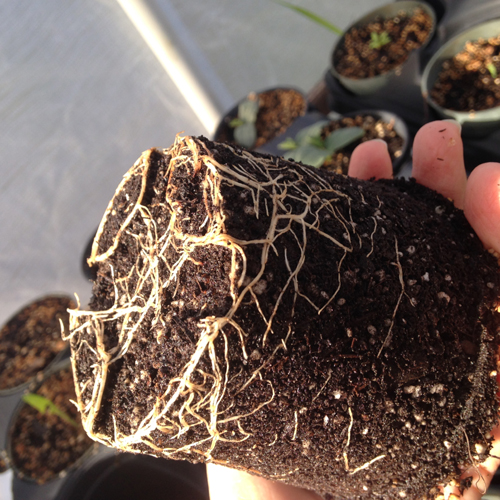
The three primary plant nutrients are:
- Nitrogen (N) – promotes strong leaf growth, dark green color.
- Phosphorous (P) – encourages healthy roots, early plant growth, seed formation.
- Potassium (K) – for plant vigor, disease and stress resistance, and flavor.
A number analysis corresponding to each of these nutrients (NPK) is listed on most commercial potting mixes. Depending on the type of plants you will be growing, you can adjust the proportions of each of these nutrients to meet their specific needs. Plants also require the secondary nutrients (calcium, magnesium, and sulfur) along with trace amounts of micronutrients.
Optimal soil PH for most plants is within a range of 5.5 – 7.0. PH levels can be adjusted to be outside this range for plants with special needs. A pH value of 7.0 is neutral. Readings below 7.0 are acidic and those above 7.0 are alkaline.
To begin making a soilless potting mix, you will first need to consider how long the plant will be growing in its pot and how soon you will need to begin fertilizing. A basic seed starting mix only needs enough nutrients to get the plant started. These usually contain only a few ingredients – peat moss or coconut coir, or pine bark or any combination of these along with perlite and/or vermiculite and sometimes compost. A small amount of added fertilizer will help keep the seedlings growing for 4-6 weeks when they can be transplanted. When planning to grow plants in pots for longer periods of time you will need to fertilize regularly and check that the soil isn’t becoming too compacted or that the plant’s roots aren’t outgrowing their pot. Some things to consider when creating the type of growing media you would like to use is how well your mixture holds moisture, retains nutrients and provides air space.
- Peat moss – Light and porous, it absorbs 10-20 times its weight in water, but when it dries out it can shrink and actually repel water. Has little nutrient value itself, but has a high nutrient holding capacity. It is acidic; for this reason, mixtures containing peat often have lime added.
- Coconut coir – Shredded coconut husks. They are usually compressed into a block and must be rewet before use. Holds up to 10 times its weight in water, but it dries out very quickly. Contains higher levels of potassium than peat, therefore fertilization with potassium may need to be cut back and nitrogen increased. Otherwise it has little nutrient value. Can have a high salt content as salt water is sometimes used in the processing of coir fiber.
- Pine bark – Slow to break down, extending the life of the potting mix. It can increase air space around the roots of the plant. Milled or partially composted, it is sometimes used, in part, as an alternative to peat moss. Acidic.
- Leaf mold– leaves that have been broken down by fungal decomposition. It is often used in homemade potting mixes as a replacement for peat. Not available commercially. It has good water holding capacity. Drawback is that it can take a long time a long time to make. A truly renewable resource that is free and easy to make.
- Perlite – A volcanic material that has been heat-expanded, making it very light weight. It increases the porosity of the potting media, allowing for good drainage and air space. It does not hold nutrients or much water. It is pH-neutral.
- Vermiculite– A mineral that has been heated to a very high temperature to form expanded fan-like particles that contain many air spaces. This promotes aeration. Unlike perlite, it can hold nutrients and water and also contains many trace elements.
- Rice Hulls – A renewable byproduct of rice production. It is being used as a replacement for perlite by some growers. Organic sources can be somewhat costly.
- Compost– Made of decayed organic plant materials, veganic compost does not contain any animal inputs. It improves soil structure while making nutrients available to plant roots. The quality of the compost depends upon the quality of the ingredients put in.
Start by mixing your primary ingredients. Then add any organic matter you would like to use to improve the soil structure and add nutrients. There are many potting mix recipes to be found online. Most of these can be easily veganized by replacing any animal ingredients with some of the fertilizers I mentioned above. Here are a couple examples to get you started.
Basic Soilless Mix
2-3 parts leaf mold, peat moss, or coco coir – or a mixture of these
1 part perlite or vermiculite
1-2 parts compost
To this add: 1-2 tablespoons dolomite lime per gallon and 2tbsp kelp meal or green sand per gallon.
Basic Soil based mix
1 part top soil or garden loam
1 part sharp builder’s sand, vermiculite, or perlite
1 part leaf mold, peat moss, or coco coir – or a mixture of these
What adjustments and amendments you add to this will depend upon the soil you use and whether or not it consists of more sand, silt, or clay and how much organic matter and nutrients it contains. Adding nutrient rich plant based compost is often all that is needed.
A good growing medium should be crumbly, yet firm enough to roll between your hands when moist. It should not feel gritty or sticky.
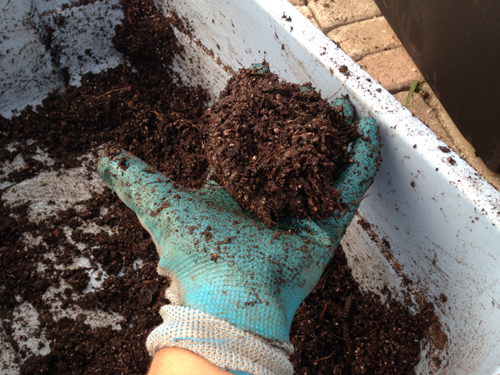
This is a potting mix recipe that I created. I have begun using it this season with consistently good results, starting plants from seeds and growing them to about second leaf stage. I then transplant them to the garden.
4 parts sphagnum peat moss
3 parts perlite
3 parts plant based compost
To this mixture, for each gallon, I add:
1.5 tbsp. dolomite lime https://amzn.to/2Ss4XUi
1.5 – 2 tbsp. kelp meal
1.5 tbsp. rock phosphate https://amzn.to/3bWdqXy
1tsp. humic acids https://amzn.to/3bXnC2d
Note: As an Amazon Associate I earn from qualifying purchases when you click on the links above. These are the actual products that I used and would use again.
Once I have combined all of these ingredients together I wet it down and mix again thoroughly. I then let it sit for 1-2 weeks, while stirring daily, giving the microorganisms time to multiply and stabilize the mix.
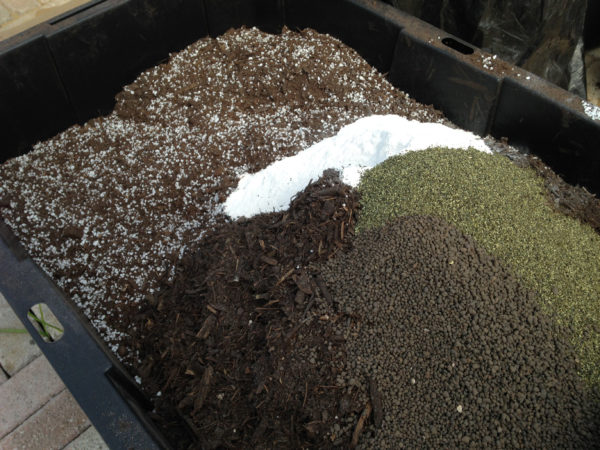
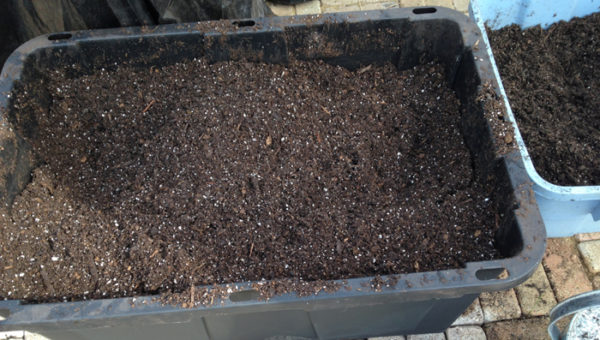
I think it is important to note here that I am not an expert at container gardening. Most of this info was obtained in research while trying to find a vegan organic growing media to start my seeds in. Most of my gardening is done in the ground. However, while doing this research I realized there was a need for vegans to have this info if wishing to grow in containers or even to fertilize their growing beds. I encourage all of you to do further research and to share your potting mix recipes. I think it is also important to consider the sustainability of these products and to try and choose the most sustainable options within your budget.
Some of the things to consider when looking for sustainable alternatives are renewability and miles of transport. Peat moss, for example, is harvested from bogs and other wetlands. Sphagnum peat moss comes from about 40,000 acres of bogs in Canada with less than 1% harvested annually. However bogs grow at a very slow rate. In the U.S. about 81% of peat harvested is reed sedge peat which is being stripped from sensitive wetlands. Many consider sphagnum peat to be more sustainable, but most would agree that finding an alternative to peat moss altogether would be better. I myself have begun the long process of making leaf mold to add to future mixes. Coco coir usually involves long transportation miles, the main producers being in India and Sri Lanka. Mining operations, such as those that extract minerals, are removing matter that cannot be replaced. Fortunately, when we add these minerals to our soil most will be released slowly and last for many years, reducing need to add more in the future. One alternative to buying rock dust is to consider crushing local rocks to meet some of these needs. This of course will depend upon the type of rocks in your location.
All of this being said, by growing our food veganicly we are already moving toward a more sustainable future. Our food won’t require as many long transportation miles. It won’t add harmful chemicals and pesticides into the soil and atmosphere. It won’t require growing large amounts of grain to feed livestock. It doesn’t support factory farming operations, one of the largest polluters on the planet. It takes control of our food back from corporations and puts it in our own hands. And it fosters a compassionate attitude which leads to peaceful relationships. Most importantly, it brings us closer to a vegan world.

